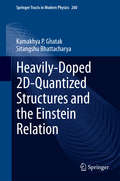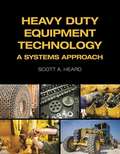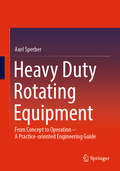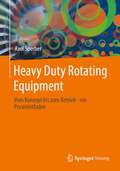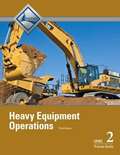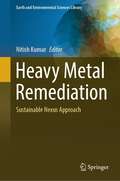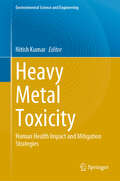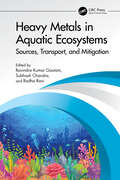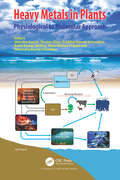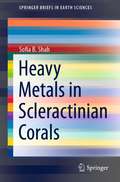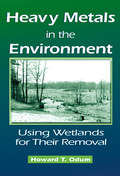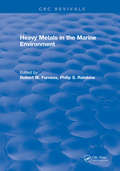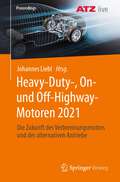- Table View
- List View
Heavily-Doped 2D-Quantized Structures and the Einstein Relation
by Sitangshu Bhattacharya Kamakhya P. GhatakThis book presents the Einstein Relation(ER) in two-dimensional (2-D) Heavily Doped (HD) Quantized Structures. The materials considered are quantized structures of HD non-linear optical, III-V, II-VI, Ge, Te, Platinum Antimonide, stressed materials, GaP, Gallium Antimonide, II-V, Bismuth Telluride together with various types of HD superlattices and their Quantized counterparts respectively. The ER in HD opto-electronic materials and their nanostructures is studied in the presence of strong light waves and intense electric fields on the basis of newly formulated electron dispersion laws that control the studies of such quantum effect devices. The suggestion for the experimental determination of HD 2D and 3D ERs and the importance of measurement of band gap in HD optoelectronic materials under intense built-in electric field in nanodevices and strong external photo excitation (for measuring photon induced physical properties) are also discussed in this context. The influence of crossed electric and quantizing magnetic fields on the ER of the different 2D HD quantized structures (quantum wells, inversion and accumulation layers, quantum well HD superlattices and nipi structures) under different physical conditions is discussed in detail. This monograph contains 100 open research problems which form the integral part of the text and are useful for both Ph. D aspirants and researchers in the fields of condensed matter physics, solid-state sciences, materials science, nano-science and technology and allied fields.
Heaviness in Metal Music Production, Volume I: How and Why It Works
by Mark Mynett Jan-Peter HerbstHeaviness in Metal Music Production, Volume I: How and Why It Works provides an in-depth analysis of the art and craft of producing heaviness, the fundamental musical quality in metal music. Using primarily ethnographic research which draws on interviews and engineering documentation from various producers across different generations, the distinguishing feature of the study is the song ‘In Solitude’, which was written, recorded, and produced by the researchers themselves.Written by practising musicians, producers, and experts in music technology and musicology, this book offers a comprehensive understanding of the interplay between structural, performative, and technological components of a metal recording; the perceptual and discursive factors determining heaviness; and the relationship between creative freedom and technical demands in contemporary metal music production.Heaviness in Metal Music Production is a rigorous academic study that advances the field of metal music production research through an innovative and methodologically robust approach. At its core is an unprecedented experiment in which eight leading producers each mixed the same song, with their processes meticulously documented and analysed through in-depth interviews. This study not only provides unique insights into the conceptualizations and craft of heaviness in metal music production but also sets a new standard for empirical research in the discipline. As a result, it serves as a vital resource for scholars, researchers, and students in audio engineering and metal music studies, making it essential supplementary reading for advanced undergraduates, postgraduates, and academics engaged in these fields. This two-volume set offers a well-rounded insight into the production of heaviness in theory and practice.The Open Access version of this book, available at www.taylorfrancis.com, has been made available under a Creative Commons Attribution (CC-BY) 4.0 International license.
Heavy Duty Equipment Technology: A Systems Approach (Automotive Diesel And Heavy Duty Ser.)
by Scott HeardFor trade school and college-level courses in Heavy Duty Equipment A Practical Guide to Working with Heavy Equipment Heavy Duty Equipment Technology: A Systems Approach is a comprehensive textbook that covers the latest technology in machine systems. Using common language and real work experiences that students and instructors can relate to, Heavy Duty Equipment is designed to be a primary reference tool. In this First Edition, system operational principles and safety practices are discussed in simple terms to help students quickly grasp key concepts and gain a base level of understanding that they can build on with work experience. With a strong foundation in place, students will be well-equipped to understand system servicing as well as repair requirements and procedures. Written from both a technician's and a professor's perspective, Heavy Duty Equipment is a "bumper to bumper" textbook that covers ALL systems found on heavy duty machinery.
Heavy Duty Rotating Equipment: From Concept to Operation - A Practice-oriented Engineering Guide
by Axel SperberThe selection and procurement of compressors and steam turbines for use in the chemical and process industry is highly interdisciplinary. The success of a project is determined by a number of areas of knowledge: from mechanical, electrical, materials and control engineering knowledge to thermodynamics, fluid mechanics and strength theory through to project management and quality control. In this guide, the individual steps are presented along the chronological chain, together with the basic decisions and pitfalls that need to be taken into account. The work is limited to custom-built machines that are specially optimized for a specific process and to gases and vapours as conveying media. It is presented from the operator's point of view with a focus on high system availability, safety and favorable conditions for maintenance and servicing.
Heavy Duty Rotating Equipment: Vom Konzept bis zum Betrieb - ein Praxisleitfaden
by Axel SperberAuswahl und Beschaffung von Verdichtern und Dampfturbinen für den Einsatz in der chemischen und Prozessindustrie ist sehr stark interdisziplinär geprägt. Über den Erfolg eines Projekts entscheidet eine Reihe von Wissensgebieten: von mechanischen, elektrischen, werkstoff- und regelungstechnischen Kenntnissen über die Thermodynamik, Strömungs- und Festigkeitslehre bis hin zu Projektmanagement und Qualitätskontrolle. In diesem Leitfaden werden entlang der zeitlichen Ablaufkette die einzelnen Schritte dargestellt, mit ihren Grundentscheidungen und Fallstricken, die dabei zu beachten sind. Das Werk beschränkt sich auf Einzelanfertigungen von Maschinen, die speziell auf einen spezifischen Prozess hin optimiert sind, ferner auf Gase und Dämpfe als Fördermedien. Dabei erfolgt die Darstellung aus Sicht des Betreibers mit einem Fokus auf hoher Anlagenverfügbarkeit, Sicherheit und günstigen Bedingungen für Wartung und Instandhaltung.
Heavy Equipment Operation and Maintenance Manual
by Ernesto A. GuzmanStarting from the purchase of heavy equipment and following through to the end of its economic life, this manual explains how to efficiently maintain and operate different types of heavy equipment. Assigning heavy equipment to different projects and utilizing them in varied systems is a large part of construction operation; ensuring everything is monitored consistently and maintained accordingly is essential. This book aids engineers in facilitating straightforward, consistent reporting systems and cost-efficient equipment use. This is particularly of note to the construction industry. Features: • Enables engineers to save time and money on maintenance costs and maximize the availability of the heavy equipment • Provides comprehensive coverage of methods and procedures for heavy equipment management • Provides charts for practical use by engineers in the field, e.g., mapping out a maintenance schedule • Includes chapters on maintenance and field operations organization, including safety and security organization This book will be of interest to construction engineers, plant engineers, mechanical engineers, maintenance plant and field engineers.
Heavy Equipment Operations Level 2 Trainee Guide (Third Edition)
by NccerWelcome to your second year of training in heavy equipment operations. If you are training under an NCCER Accredited Training Program Sponsor, you have successfully completed Heavy Equipment Operations Level One, and are well on your way to more advanced training. Heavy equipment operators work on a wide variety of projects, including building construction, and on roads, bridges, mining, and timber operations, just to name a few. New construction and infra-structure projects continue to increase the demand for qualified operators. The skills qualified operators provide are vital for clearing sites, moving materials, or any earthmoving operations.
Heavy Equipment Operations, Level 1
by NccerThis exceptionally produced trainee guide features a highly illustrated design, technical hints and tips from industry experts, review questions and a whole lot more! Key content includes: Orientation to the Trade, Heavy Equipment Safety, Identification of Heavy Equipment, Basic Operational Techniques, Utility Tractors, Introduction to Earth Moving, and Grades-Part One.
Heavy Equipment Power Trains And Systems
by Timothy W. DellHeavy Equipment Power Trains will help educate college students who aspire to a career in the off highway industry, primarily servicing construction and agricultural machinery. The text is designed for post-secondary courses on power trains and related systems, which include brakes, suspension, tires and tracks, and steering. The text covers all the competencies required by AED for power trains, along with safety and selected critical functions in hydraulics/hydrostatics. To appeal to visual learners, discussions of theory and servicing are supported with more than 1000 images comprised of multi-color line art, cross sectional drawings, and photographs. Technology examples are drawn from a variety of manufacturers in order to help students put theory into practice. To supplement what students will learn in the shop, helpful techniques for diagnosing, servicing and repairing heavy equipment systems appear throughout the text.
Heavy Metal Contamination in Wastewater and Its Bioremediation by Microbial-Based Approaches (Advances in Wastewater Research)
by Maulin P. Shah Vishal Mishra Sachchida Nand Rai Veer SinghThis book covers various aspects of heavy metal contamination in wastewater and its removal by microbial-based approaches. The heavy metal contamination in water is generally caused due to natural and anthropogenic activities. There are many industrial processes responsible for such a contamination, for example, leather tanning, coal washeries, agriculture activities, chrome plating and paint industries. The industrial effluent directly or indirectly discharges into water sources, and heavy metal containing wastewater decreases the quality of surface water and groundwater. The heavy metal contamination causes various types of health issues in human and other living organisms, including kidney and liver damage, heart failure, mental retardation, cancers, and skin and gastric problems. The high level of heavy metal concentration in the cell generates reactive oxygen species (ROS) which may cause damage to cell organelles. Due to their high toxicity, there is an urgent need to develop effective heavy metal removal method for wastewater treatment. There are several conventional methods available for the removal of heavy metal ions from contaminated sites. These methods have some disadvantages such as the generation of secondary toxic sludge and high operation cost. Hence, it is required to develop cost-effective and eco-friendly methods for decontamination. Microorganisms have tendency to accumulate heavy metal ions into their intracellular space and can grow in various high-stress environments, and microbial-based methods are considered as eco-friendly and cost-effective. Moreover, the integrated approach of wastewater treatment and utilization of microbial biomass for bioenergy production can be beneficial in terms of heavy metal bioremediation and zero waste generation. This book focuses on the heavy metal contamination, their toxicity and microbial methods for the removal of heavy metal ions from contaminated sites.
Heavy Metal Contamination in the Environment: Health Impacts and Potential Remediation Approaches
by Ashish Kumar Vishal Mishra Sachchida Nand Rai Veer SinghThis reference book explores the multifaceted problem of heavy metal contamination in the environment. Through its in-depth analysis, the book provides a thorough overview of the sources and pathways of heavy metals, their persistence in ecosystems, and the resulting health impacts on individuals and ecosystems. The chapters explore the diverse sources of contamination, including industrial activities, mining, agriculture, and urbanization, while examining the types of heavy metals found in the environment and their toxicological properties. The book further reviews the profound health effects associated with heavy metal exposure, such as neurological disorders, developmental abnormalities, carcinogenicity, and organ damage. Furthermore, the book provides insights into risk assessment methodologies, regulatory frameworks, and guidelines aimed at controlling and minimizing heavy metal exposure. It highlights the challenges and gaps in current regulations, identifies potential areas for improvement, and presents analytical techniques for heavy metal analysis and removal. This book is an important source for researchers and professionals working in the fields of environmental science, toxicology, and public health.
Heavy Metal Contamination of Soils
by Ajit Varma Irena SherametiFollowing a description of the various sources and factors influencing the contents of heavy metal pollution in post-catastrophic and agricultural soils, subsequent chapters examine soil enzymes and eggs as bio-monitors, lead adsorption, the effects of arsenic on microbial diversity, and the effects of Mediterranean grasslands on abandoned mines. A third section focuses on the adaptation strategies used by plants and bacteria, such as Pinus sylvestris in industrial areas, and the rhizosphere in contaminated tropical soils and soil treated with sewage sludge. Further topics addressed include strategies of bioremediation, e. g. using transgenic plants as tools for soil remediation. This new volume on heavy metals in soil will be of interest to researchers and scholars in microbial and plant biotechnology, agriculture, the environmental sciences and soil ecology.
Heavy Metal Remediation: Sustainable Nexus Approach (Earth and Environmental Sciences Library)
by Nitish KumarHeavy metals, in general trace elements, are one of the major environmental problems. Nowadays, increasing environmental and global public health concerns related with environmental contamination by heavy metals are well known. Moreover, human exposure has risen dramatically because of an exponential increase of their use in several activities such as agricultural, industrial, technological and urban applications. They are presented in soils, water and atmosphere and they are a serious risk for the food chain.Approximately 10 million contaminated sites have been reported globally, occupying approximately 49.42 million acres of land, of which >50% is contaminated with toxic heavy metals. This situation warrants immediate attention to limit the introduction of heavy metals into soil systems and to remove the prevailing heavy metals from polluted soils. However, the majorities of existing heavy-metal-removal technologies are expensive, inefficient, or generate secondary pollutants. Therefore, it is of great importance to develop cheaper, environmentally friendly and sustainable approaches (including the development of new immobilizing agents) to manage and rehabilitate heavy-metal-contaminated soils. In the light of the aforementioned facts, this book sheds light on this global environmental issue, and proposes solutions to contamination through multi-disciplinary approaches and case studies from different parts of the world. It addresses sustainable heavy metal contamination remediation strategies using the potential applications of recent biological technology such as biotechnology, bioremediation, phytoremediation, biochar, absorbent, genetic engineering, and nanotechnology approaches. This book is of interest to researchers, teachers, environmental scientists, environmental engineers, environmentalists, and policy makers. Also, the book serves as additional reading material for undergraduate and graduate students of environmental microbiology, biotechnology, eco-toxicology, environmental remediation, waste management, and environmental sciences as well as the general audience.
Heavy Metal Stress in Plants
by Francisco J. Corpas Dharmendra K. Gupta José M. PalmaPlants possess a range of potential cellular mechanisms that may be involved in the detoxification of heavy metals and thus tolerance to metal stress. Metal toxicity causes multiple direct and indirect effects in plants that concern practically all physiological functions. The main purpose of this book is to present comprehensive and concise information on recent advances in the field of metal transport and how genetic diversity affects heavy metal transport in plants. Other key futures of the book are related to metal toxicity and detoxification mechanisms, biochemical tools for HM remediation processes, molecular mechanisms for HM detoxification, how metallomics and metalloproteomics are affected by heavy metal stress in plants, and the role of ROS metabolism in the alleviation of heavy metals. Some chapters also focus on recent developments in the field of phytoremediation. Overall the book presents in-depth information and the most essential advances in the field of heavy metal toxicity in plants in recent years.
Heavy Metal Toxicity: Human Health Impact and Mitigation Strategies (Environmental Science and Engineering)
by Nitish KumarThis edited book brings together a diverse group of environmental science, sustainability, and health researchers to address the challenges posed by global mass poisoning caused by heavy metals contamination of soil and plants. In recent years, contamination of the environment by heavy metals has become a major concern. Their multiple industrial, domestic, agricultural, medical, and technological applications have led to their wide distribution in the environment, raising concerns over their potential effects on human health and the environment. Owing to their toxic, non-degradable, and bio-accumulative nature, the health burden on the population has increased significantly. Heavy metals such as arsenic, lead, mercury, cadmium, and uranium do not play a significant role in metabolism in the human body and are thus toxic. Their exposure in high concentration can cause acute toxicity resulting in acute health conditions, which is easy to observe and regulate, while similar is not visible for immediate action when their exposure is in trace amounts over the years. Heavy metals enter in the food chain through consumption of plant material. A high concentration of heavy metals has been found to be harmful to vegetation. As the heavy metals concentration in plants increases, it adversely affects several biological parameters and eventually renders the soil barren.The book sheds light on this global environmental issue and proposes solutions to contamination through multi-disciplinary approaches and case studies from different parts of the world. This book is a valuable resource to students, academicians, researchers, and environmental professionals who are doing field work on heavy metals contamination throughout the world.
Heavy Metals in Aquatic Ecosystems: Sources, Transport, and Mitigation
by Subhash Chandra Ravindra Kumar Gautam Radha RaniHeavy metals are hazardous environmental pollutants and are becoming one of the most serious environmental problems because of their persistence, toxicity, non-biodegradability, and ability to be incorporated into the food chain. This book provides state-of-the-art techniques and technologies for the assessment and remediation of heavy metal ions from aquatic ecosystems. It discusses sources, fate, transport, health risk assessment, and remediation of heavy metals and the current methods for source identification and tracking, including the use of stable isotopes, fingerprinting techniques, and advancements in molecular biology for environmental monitoring.Features Provides state-of-the-art techniques and technologies for assessment and remediation of heavy metal ions from the aquatic ecosystem. Covers up-to-date information on heavy metals pollution in the freshwater ecosystems, rivers, and lakes. Discusses the hazardous impacts of heavy metals on various ecosystems including human health, and remediation technologies. Explains the toxicity of arsenic and mercury in the food and crop ecosystems. Offers in-depth exploration of recent technological advancements in environmental monitoring, especially in relation to toxic elements in aquatic ecosystems. This book serves as an excellent reference for both professionals and students and is the first of its kind to highlight the toxicity of heavy metals. Researchers, post-graduate students, and advanced undergraduate students in environmental science and engineering, soil and water sciences, biotechnology, and chemical engineering, as well as environmental and technical engineers, ecologists, and applied environmental scientists and managers, will benefit from the extensive coverage given in this book.
Heavy Metals in Plants: Physiological to Molecular Approach
by Jitendra Kumar, Shweta Gaur, Prabhat Kumar Srivastava, Rohit Kumar Mishra, Sheo Mohan Prasad and Devendra Kumar ChauhanThis book focuses on the menace of metal pollution and its impact on plants, particularly food grains, pulse and vegetable plants covering morphological, anatomical, physiological and biochemical aspects. It includes comparative studies among metal hyper-accumulators (metallophytes) and non-accumulators including exogenous hormonal alleviation in them due to metal stress. Low dose stimulation effects are also reviewed. The most significant feature of the book is its extensive coverage of genomics, metabolomics, ionomics, proteomics and transcriptomics in metal non-hyper-accumulators and hyper-accumulators. Being an edited volume, the book incorporates a variety of research perspectives, enhancing the existing knowledge about metal pollution and points to newer avenues to be researched.
Heavy Metals in Scleractinian Corals (SpringerBriefs in Earth Sciences)
by Sofia B. ShahThis book provides an in-depth review of heavy metals in corals, describing the sources of heavy metals in the marine environment and their effect on corals. It is designed to serve as a unique reference for upcoming marine researchers and chemists, advanced undergraduate and postgraduate students as well as those interested in marine pollution with respect to heavy metals. The book explains the basics as well as the state-of-the-art regarding heavy metals and corals and is engaging and clearly written and narrated, providing readers with the fundamental tools about the subject matter that they need in their specific fields. It allows readers to understand and appreciate the interactions between the atmosphere, ocean, and the geosphere. Detailed reference is included for the benefit of the reader. The specific objectives of this book are (i) to inform/educate the reader about persistent pollutants such as heavy metals, (ii) to identify sources of heavy metals in the marine environment, (iii) to inform about route of exposure and uptake of the heavy metal pollutants by corals, (iv) to elaborate about the effect of heavy metal pollutants on the coral reef ecosystems, (v) to discuss the ways in which heavy metal regulation occurs in corals, (vi) to impact current knowledge regarding heavy metals in the marine environment, and (vii) to briefly show chemical analysis and instrumentation for analyzing heavy metals.
Heavy Metals in the Environment (Advances in Industrial and Hazardous Wastes Treatment)
by Lawrence K. Wang Yung-Tse Hung Nazih K. Shammas Jiaping Paul ChenA successful modern heavy metal control program for any industry will include not only traditional water pollution control, but also air pollution control, soil conservation, site remediation, groundwater protection, public health management, solid waste disposal, and combined industrial-municipal heavy metal waste management. In fact, it should be
Heavy Metals in the Environment: Using Wetlands for Their Removal
by Howard T. Odum Lowell Pritchard Wlodzimierz Wójcik Shanshin Ton Joseph J. Delfino Malgorzata Wójcik Slawomir Leszczynski Jay D. Patel Steven J. Doherty Jacek StasikMuch of the convenience of modern life resides in sheet metal, the cowling shield of most machines and appliances. However, the load that this takes off human shoulders has to be carried elsewhere, and the Earth has borne the burden. Many of us woke up to the environmental cost when over a century of industrialization finally surpassed the capacity
Heavy Metals in the Marine Environment
by Robert W. FurnessThe aim of this volume is to draw together state-of-the-art reviews of knowledge onlevels of heavy metals in marine environments (particularly in marine animals), the dynamicprocesses in these systems, toxic effects, and threats presented by heavy metals in foods ofmarine origin.All heavy metals, whether biologically essential or not, have the potential to be toxicto organisms at a threshold bioavailability. Such threshold concentrations vary betweenmetals, between species and with the physicochemical characteristics of the medium, somelike copper being particularly toxic even though essential in trace amounts. Responses ofanimals to metals in their medium or food depend to a large extent on the ability of speciesto regulate levels attained in their tissues. Higher animals have the capacity to regulate levelsof many metals, while marine invertebrates can regulate some within certain limits. Whereanimals cannot regulate physiological levels of metals, an alternative strategy is to detoxifyand store metals in relatively harmless forms. Knowledge of the manner in which animals deal with potentially toxic concentrations of heavy metals is of fundamental importance in the assessment of metal pollution by analysis of metal levels in biological samples. The interaction of heavy metals with biological materials is a key theme running through this volume. Toxic effects may be reflected at the individual, population, or ecosystem level, affecting species composition and production levels, or may be of direct dietary significance to man. The global cycling of metals through the marine environment is crucially affected by biological processes.
Heavy Oil Exploitation
by Abdul Jamaluddin David Hin-Sum Law Shawn David Taylor Simon Ivar AndersenHeavy crude oils have a unique chemical nature that creates many technical challenges. In this new book, four heavy oil and bitumen experts deliver a comprehensive look at the complexities of this alternative petroleum resource. With its high viscosity and complex hydrocarbon chemistry, heavy oil requires technical personnel to use innovative approaches to enable it to flow in a porous formation and also in the production circuit and finally to treat and convert it into valuable products. While plentiful deposits exist throughout the world, this heavy hydrocarbon requires upgrades in skill and process to extract, transport, and refine. KEY FEATURES: Characteristics of heavy oil Traditional and newest recovery methods Construction and completion of a heavy oil well A discussion of gas lifting, pumping systems, and sand management Unique transportation and processing requirements Overview of upgrading and refining requirements
Heavy Weather
by Bruce SterlingA near-future eco-thriller from the bestselling author of Schismatrix Plus and The Difference Engine. The Storm Troupers are a group of weather hackers who roam the plains of Texas and Oklahoma, hopped up on adrenaline and technology. Utilizing virtual reality, flying robots, and all-terrain vehicles, they collect data on the extreme storms ravaging an America decimated by climate change. But even their visionary leader can&’t predict the danger on the horizon when a volatile new member joins their ranks and faces a trial by fire: a massive tornado unlike any the world has seen before. &“A remarkable and individual sharpness of vision . . . Sterling hacks the future, and an elegant hack it is.&” —Locus &“Lucid and tremendously entertaining. Sterling shows once more his skills in storytelling and technospeak. A cyberpunk winner.&” —Kirkus Reviews &“So believable are the speculations that . . . one becomes convinced that the world must and will develop into what Sterling has predicted.&” —Science Fiction Age &“A very exciting coming-of-age story in a wild future America . . . What&’s it got? Cyberpunk attitude, genuine humor, nanotechnology, minimal sex but some cool medications and very big weather systems.&” —SFReviews.net &“Brilliant . . . Fascinating . . . Exciting . . . A full complement of thrills.&” —The New York Review of Science Fiction
Heavy-Duty-, On- und Off-Highway-Motoren 2021: Die Zukunft des Verbrennungsmotors und der alternativen Antriebe (Proceedings)
by Johannes LieblDie inhaltlichen Schwerpunkte des Tagungsbands zur ATZlive-Veranstaltung Heavy-Duty-, On- und Off-Highway-Motoren 2020 sind unter anderem neue Diesel- und Gasmotoren, Schadstoffreduzierung, Powertrain-Konzepte für den On- und Off-Highway-Bereich, Einspritzung sowie die Komponentenentwicklung im Hinblick auf das System. Die Tagung ist eine unverzichtbare Plattform für den Wissens- und Gedankenaustausch von Forschern und Entwicklern aller Unternehmen und Institutionen, die dieses Ziel verfolgen.Der InhaltDie ZielgruppenFahrzeug- und Motoreningenieure sowie Studierende, die aktuelles Fachwissen im Zusammenhang mit Fragestellungen ihres Arbeitsfeldes suchen - Professoren und Dozenten an Universitäten und Hochschulen mit Schwerpunkt Kraftfahrzeug- und Motorentechnik - Gutachter, Forscher und Entwicklungsingenieure in der Automobil- und ZulieferindustrieDer VeranstalterATZlive steht für Spitzenqualität, hohes Niveau in Sachen Fachinformation und ist Bestandteil der Springer Fachmedien Wiesbaden GmbH, ein Teil von Springer Nature. Hier wird unter einem Dach das Know-how der renommiertesten Wirtschafts-, Wissenschafts- und Technikverlage Deutschlands vereint.
Heavy-Duty-, On- und Off-Highway-Motoren 2022: Stand der Energiewende im Heavy-Duty-Bereich (Proceedings)
by Alexander HeintzelDie inhaltlichen Schwerpunkte des Tagungsbands zur ATZlive-Veranstaltung "Heavy-Duty-, On- und Off-Highway-Motoren 2022" sind unter der Überschrift "Stand der Energiewende im Heavy-Duty-Bereich" unter anderem Antriebe für zukünftige Kraftstoffe, Emissionsgesetzgebung und ihre Erfüllung sowie neue Diesel, Gas- und Dual-Fuel-Motoren. Die Tagung ist eine unverzichtbare Plattform für den Wissens- und Gedankenaustausch von Forschern und Entwicklern aller Unternehmen und Institutionen, die dieses Ziel verfolgen.Der Inhalt: Motoren für zukünftige Kraftstoffe. - Test, Verbrennung, Nachbehandlung. - Werkstoff-Komponenten. - Künftige Energiesysteme und Infrastruktur. - Brennstoffzellen.Die ZielgruppenFahrzeug- und Motoreningenieure sowie Studierende, die aktuelles Fachwissen im Zusammenhang mit Fragestellungen ihres Arbeitsfeldes suchen - Professoren und Dozenten an Universitäten und Hochschulen mit Schwerpunkt Kraftfahrzeug- und Motorentechnik - Gutachter, Forscher und Entwicklungsingenieure in der Automobil- und ZulieferindustrieDer VeranstalterATZlive steht für Spitzenqualität, hohes Niveau in Sachen Fachinformation und ist Bestandteil der Springer Fachmedien Wiesbaden GmbH, ein Teil von Springer Nature. Hier wird unter einem Dach das Know-how der renommiertesten Wirtschafts-, Wissenschafts- und Technikverlage Deutschlands vereint.
